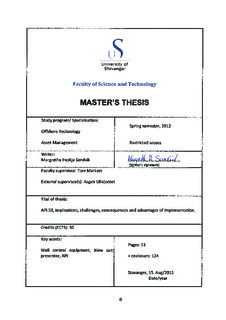| dc.contributor.author | Sandvik, Margrethe | |
| dc.date.accessioned | 2014-02-06T09:21:33Z | |
| dc.date.issued | 2012 | |
| dc.identifier.citation | konf til aug 2014 | no_NO |
| dc.identifier.uri | http://hdl.handle.net/11250/183129 | |
| dc.description | Master's thesis in Offshore technology | no_NO |
| dc.description.abstract | The goal with this thesis was to look into consequences for implementing the API 53
standard for Transocean Norway. As it looks today the new requirements in the API
53 will be implemented as internal requirements within Transocean. Transocean
operates in all the major oil and gas markets in the world and cannot operate with
different regulations for each area. There is as of today no indication of regulatory
requirements to change in Norway as a consequence of the new API 53. There may
however be an updated version of Det Norske Veritas (DNVs) offshore standard (OS)
with regards to drilling plant.
I will in this thesis look into what Transocean Norway have to do to be in compliance
with the new Standard and thereby new internal requirements. To be able to find the
what actions Transocean Norway have to do I have made a GAP analysis between the
new API 53 and Transocean Well Control Handbook. This has been a comprehensive
work and I will in this thesis look into the findings. The API 53 contains mostly good
oil field practice which has not been stated as a standard in the past, but there are
also new requirements especially with regards to backup systems and secondary
control systems as Emergency Shut Down (ESD), Autoshear, Deadman and ROV
intervention all as a consequence of Macondo. Testing procedures is also more
comprehensive than before and there are both positive and negative sides with this.
The main goal of a new standard like API 53 is increased reliability and safer
operation on an oil rig. For 5 out of 7 rigs Transocean Norway will have to upgrade
the Blow out preventers (BOPs) and associated equipment with new technical
solutions which has to be provided and engineered by Original equipment
manufacturers (OEMs). I will look into the different implications, challenges and
advantages with an implementation. | no_NO |
| dc.language.iso | eng | no_NO |
| dc.publisher | University of Stavanger, Norway | no_NO |
| dc.relation.ispartofseries | Masteroppgave/UIS-TN-IKM/2012; | |
| dc.subject | offshore technology | no_NO |
| dc.subject | driftsledelse | no_NO |
| dc.subject | blow out preventer | no_NO |
| dc.subject | well control equipment | no_NO |
| dc.subject | API | no_NO |
| dc.title | API 53, implications, challanges, consequences and advantages of implementation | no_NO |
| dc.type | Master thesis | no_NO |
| dc.subject.nsi | VDP::Technology: 500::Marine technology: 580::Offshore technology: 581 | no_NO |
| dc.description.embargo | 2014-08-15 | |
